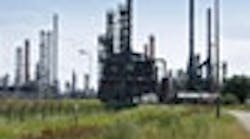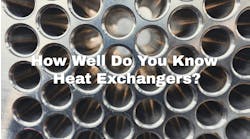It is very rare to see a process plant without a heat exchanger. Usually, the effectiveness of the heat exchanger is critical and, in some cases, even determines the overall energy efficiency of the plant.
Heat exchanger design addresses the suitability for the fluids involved and maintainability, among other factors (see "Keep Others from Making 'Classic' Mistakes"). Here, however, we'll focus on existing heat exchangers.
The effectiveness of a heat exchanger installed in a process plant is governed by the following three parameters: 1. the area available for heat transfer; 2. the overall heat transfer coefficient; and 3. the difference in temperature between the hot and cold fluids.
Because plant engineers don't have much control over the area of an existing heat exchanger, let's focus on the overall heat transfer coefficient and the temperature difference. In simplified terms, heat exchanger effectiveness drops due to both fouling of the heat exchange surface and falling approach temperature in the exchanger.
[pullquote]Exchanger fouling is the most common problem encountered that silently robs the efficiency of a heat exchanger. Fouling not only reduces heat exchanger effectiveness but, in certain cases, could lead to more valuable process streams being put into less valuable byproduct streams. For example, petroleum refineries suffer when marketable propane and butane (LPG) are dumped into the non-saleable fuel gas stream due to less efficient heat exchanger systems.
The plant engineers must evaluate the frequency needed for exchanger tubes' cleaning to maintain the fouling at low levels. Both on-line and off-line cleaning techniques are available to minimize exchanger tube fouling. Also, in certain types of heat exchangers, such as water-cooled condensers, it is essential to analyze the quality of cooling water periodically and to control its scaling properties. For more on fouling, check out "Avoid Fouled Exchangers."
Monitoring the approach temperature is also crucial to process equipment — especially those linked to water-cooled condensers. When the cooling water to a power-plant turbine condenser is supplied 5°F above normal, the vacuum in the condenser — and consequently the turbine power output — could drop by 1–2%. For turbo-alternators with capacities over 10MW, this would result in a huge power output loss for every operating hour.
In plants with multiple streams of process heating and cooling, it is necessary to conduct a Pinch analysis. Now, well-tailored heat-exchanger-network software programs are available for optimizing a plant's overall heat-transfer operations. For smaller plants, simple spreadsheet-based software programs can handle Pinch analysis. Such analysis can help modern plants achieve higher heat recovery, lower cooling tower loads and decreased heat input at the process heaters.
Consider the following techniques, as applicable, to optimize heat exchanger efficiency:
1. Changing from series to parallel exchanger operation. Piping modifications may allow switching heat exchangers from series to parallel operation. This might help lower pressure drop without compromising much of the heat exchangers' effectiveness.
2. Checking and correcting exchanger tube velocities. Periodically assess the tube velocities of water-cooled exchangers with heat- and mass-balance calculations and adjust the flow to stay above a minimum of 3 ft/sec.
3. Increasing air flow to air-cooled exchangers. During summer months, boosting the fan speed in an air-cooled exchanger could compensate for the increase in air temperature.
4. Adding more heat exchanger surface. Installing more plates in plate-type heat exchangers and replacing an existing ordinary tube bundle with a high-flux one in shell-and-tube exchangers may help in some cases. (For more on shell-and-tube exchangers, see "Succeed with Condensate Control," and "Eliminate Exchanger Tubing Troubles").
5. Replacing shell-and-tube exchangers with plate heat exchangers. When the approach temperature is low, consider switching out a shell-and-tube exchanger for a plate unit.
Ven V. Venkatesan is Chemical Processing's Energy Columnist. You can e-mail him at [email protected].


